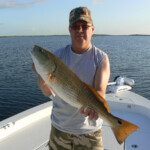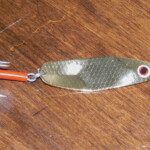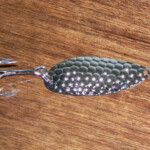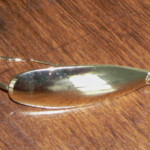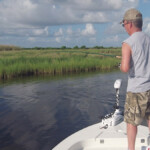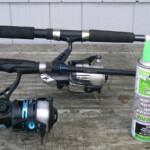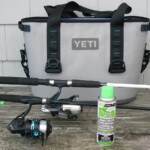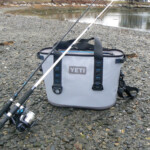Dana Benner explains why the often overlooked spoon and other metal lures still have their place in the saltwater angler’s tackle box and how anglers are returning to the practice of “throwing metals”.
Cast after cast I made to the grassy edge of a small island. On the retrieve my lure, a gold Johnson Silver Minnow, stopped dead in the water and a split second later something pulled on the other end and started taking line. My six and a half foot, medium action rod was nearly bent double and all I could do was try to keep the rod tip up and hang on. During the struggle the rod tip broke, but there was nothing I could do about it at this point. When the battle was over I was able to boat a 27½ inch red drum, or “Red” for short.
This was not my first rodeo with saltwater fishing, having spent a great deal of time along the New England coast and in the Hawaiian Islands. I cut my teeth on striped bass, bluefish, cod and haddock, but this was my first red drum. It was also my first trip to Louisiana, where I was fishing with Captain David Bourgeois of Big Dog Fishing Charters in the Baratarian Basin.

What really struck me was the gear we were using; medium action spinning tackle, the very same I would be using if I was freshwater fishing back home, was provided on the boat. Even the lure, the Johnson Silver Minnow, was something I would have thrown for Northern pike. I made a mental note and decided to see if some of these tactics would work back in my neck of the woods, including the spoon.
Arriving back home I pulled out my tackle box and wouldn’t you know it, there in the bottom was an old spoon. Probably one given to me in the dim and distant past. Seeing that old lure and combining it with my experience in Louisiana made me think about the history of spoons and their place in the arsenal of the modern saltwater angler. I decided to find out more.
A Bit of History
Research showed that “spoons” have been around for a long, long time. Native people here in North America and native Hawaiians have been using “spoon” shaped lures made from shells for centuries. Sometime in the early to mid-1800s, both in North America and in Europe, fishing turned from just being a means to put food on the table to a sport. Along with this new attitude came new gear, including commercially produced lures. One of those lures was made of metal and concave in shape and the modern “spoon” was born. History is unclear why the lure is called a spoon. It could be because the shape of the lure resembles a dinner spoon, or it could be because maybe the first designs were actually made from old dinner spoons.
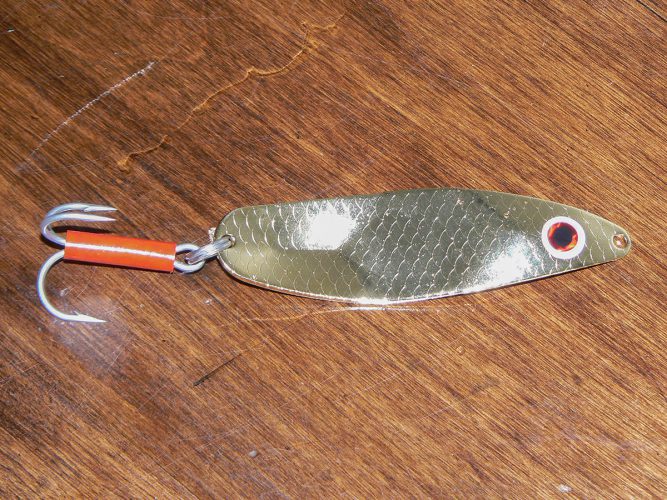
Over here in New England there is no shortage of stories, many of which you have to take with a pinch of salt, and after a while you come to realize that we like to take credit for everything. One of the stories that I have heard was that the first “commercial” spoon lure was developed by a man in Vermont named Julio Buel. It is told that Mr. Buel dropped a table spoon overboard one day. As he watched the spoon wobble to the bottom a fish swam up and grabbed it. The rest as they say, is history. Another story which originated around the coastal area and is actually believable, states that saltwater fishermen of the 1930s often fished for bluefish, pollack and striped bass using spoons made from the metal shroud around the headlights of automobiles of the time. I have no idea how true these stories are, but they are interesting.
I spoke to Kurt Mazurek at Mepps to get his input on things. He agreed that spoons have been around for many years. Their lure, the Syclops, which is a spoon that I have used to catch many different species, has been around since the mid-1980s and was designed by Henri Limouzin in France. It seems that European anglers were using spoons even after the interest had faded in America. Kurt also told me that Mepps took the idea of weedless spoons and combined it with the Syclops in the early 1990s to come up with the Timber Doodle, another spoon I have used to catch many inshore species.
Saltwater Spooning
Back in the 1960s and ‘70s everyone was using spoons because they worked. Offshore anglers were using spoons for everything from tuna to billfish. Inshore anglers were using spoons to pick up every species you could think of. Then in the 1980s and ‘90s I started noticing people moving away from spoons. They still had them, they just weren’t using them. Shunning the simplest lure, we fell victim to the new “must haves”. You know what I am talking about; those lures that are designed more to catch anglers than they are fish. The spoon was pushed to the bottom of the box.
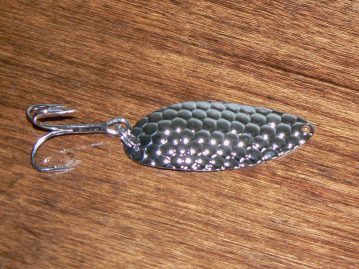

Today we have come full circle, more and more saltwater anglers are going back to the ways of their fathers and grandfathers and are throwing metals. The best news is that the lure manufacturers are listening. I already mentioned the Johnson Silver Minnow, but they aren’t the only game out there. Mepps produces both their Syclops and Timber Doodle in saltwater versions, and Acme puts out many saltwater spoons. One of my favorite lures for striped bass and bluefish is the Acme Little Cleo.
What Makes Them Work?
Most artificial lures are designed to look like a fish’s food, it is that simple. The problem with the spoon is that it doesn’t fit into that category. So what makes a spoon so effective on so many different species of fish; both fresh and saltwater? It is all in the action. Spoons are designed to wobble as they move through the water. How much they wobble is based upon how fast they are retrieved or trolled. There are many different shapes of spoons which means each one acts a bit different at alternate speeds.
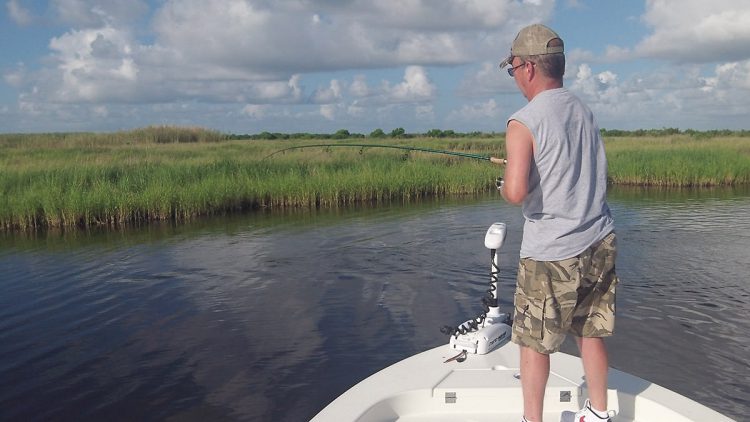
Along with the wobble comes flash. While colored spoons, which are mainly freshwater lures, will catch saltwater species, I have found that either silver or gold work best in the saltwater situation. The erratic action of the spoon, combined with the flash, seems to make the fish you are after believe that your spoon is a wounded baitfish and thus, an easy meal.
Size Does Matter
I am often asked what size spoon I use for a particular species of fish. Well, that can be an open ended question. I always say fish the size lure that will catch the bigger fish. Remember, big fish will strike a small spoon, but small fish won’t take a large spoon without difficulty. Fish are looking for food that is within their means to handle. In the majority of cases., the larger the fish, the larger the prey it will eat. It is that simple. Using the proper size spoon for the fish you are targeting will help eliminate the smaller fish. You may get fewer strikes, but the ones you get should be from larger fish.
Rods and Reels
Despite the luck we had in Louisiana, when I generally fish saltwater I like to go with heavier tackle. When fishing spoons here in New England there are four rod and reel set ups that I like to use. One of them is the seven foot, medium-heavy action Quantum Smoke rod matched with a Quantum Smoke Inshore reel. The other three are Shakespeare rods and reels and include the seven foot, medium action Tiger rod matched with a Tiger reel, the seven foot, medium action boat rod with a matching reel and the eight foot, medium action surf rod with a matching reel. All of the reels are spooled with Berkeley or Stren 12-15 pound test monofilament line. I also use a nine to 12 inch, 30 pound test fluorocarbon leader.

Spoons are very simple lures and they have proven themselves over hundreds of years of use. With this much history behind them they should not be hidden at the bottom of your box. Dig them out and use them. When that bull red or black drum almost breaks your rod in half you will be glad you did.

